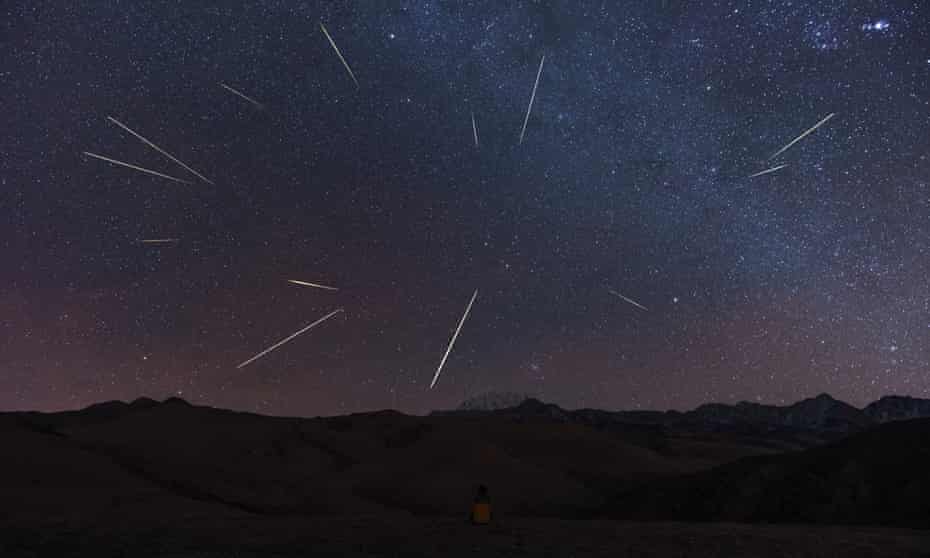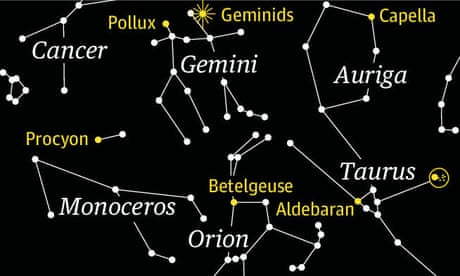Extract from The Guardian
The Geminids are expected to be most visible between 3am and 4am across the country.

The Geminids 2021 are set to light up the sky this week, with the meteor shower at their best in Australia between 3am and 4am.
First published on Mon 13 Dec 2021 17.06 AEDT
The night sky is set to be illuminated across Australia this week, as the annual Geminid meteor shower begins peaking on Tuesday morning.
The meteor shower is expected to be at its most visible between 3am and 4am in every major city, and although the meteor shower runs until Monday 20 December, it is expected to peak on Tuesday and Wednesday mornings.
Those patient enough to stay awake or set the alarm should be rewarded, with the Geminids considered one of the most spectacular meteor showers of the year.

What are the Geminids?
Each year, Earth passes through debris from an asteroid called 3200 Phaethon. Bits of it are constantly breaking off, burning up in the atmosphere and streaking across the night sky.
“This asteroid goes around the sun, bits of rock fall off of it as it goes and it kind of leaves like a wake like a boat, just going through the water,” astronomer Dr Brad Tucker from the Australian National University said.
“When we say there’s an annual meteor shower, we know that we’ll cross the same point, about this same location about the same time, but there’s some small variations that really change how many we can see.
“And the Geminids are always one of the more dependable ones, because we pass at a time when we see generally quite a few good ones of them.”
The Geminids get their name from the radiant – the point in the sky they appear from – which is in the Gemini constellation, above the north-east horizon.
What can you expect to see?
Major cities should see “a couple dozen an hour,” during the peak, Tucker says, with conditions looking good for getting a clear view.
“Clouds, moon and city lights are always the big three, and you can always get away from city lights. Astronomically, the moon is convenient this year, and then the cloud cover is always weather dependent.
“Which is why I think it’s always nice that this meteor shower kind of provides good rates over a few days. People were seeing some last night, and tonight and tomorrow morning should be really good.”
“Even in the major cities, you should be able to still see a couple of dozen per hour. We always feel lucky to see one shooting star, so seeing a couple of dozen per hour is pretty cool.”
When and where is the best time to look?
Timing is essential to seeing as much of the meteor shower as possible. Tucker says the shower is most vibrant once the moon sets.
“The best viewing is 3-4am across Australia. But when the moon sets will depend on your location, but pretty much by 2am local, the moon has set all over the country.
“That’s kind of the best chance to really start seeing it because you want that moon to be out of the way and the area of the sky to be as high as possible. So if you go outside and see the moon, it’s too early.
“If you go outside and it’s gone, you’re in business.”
He says the further north you are, the better the view will be, and that the shower will be visible to the naked eye, and that residents should try and find a dark spot to observe from.
Tucker also advises heading to a nearby park or oval to watch the meteor shower, anywhere with an unobstructed view of the sky, and to continue looking north.
Keen meteor watchers will need to be patient, and allow time for their eyes to adjust to the darkness, which could take up to 30 minutes.
“Having a nice clear view and as dark as possible, even in the cities, can mean that you’ll get a couple of dozen. And obviously, the darker [the spot], the better.”
Although the best show will come in the early hours of the morning, there are also some “Earth-grazing” meteors that will be visible earlier in the night. You can see them at the following local times:
Brisbane – 9pm
Darwin – 9.30pm
Perth – 10pm
Sydney – 10.30pm
Canberra – 10:45pm
Adelaide – 11:00pm
Melbourne – 11:00pm
Hobart – 11.30pm
No comments:
Post a Comment